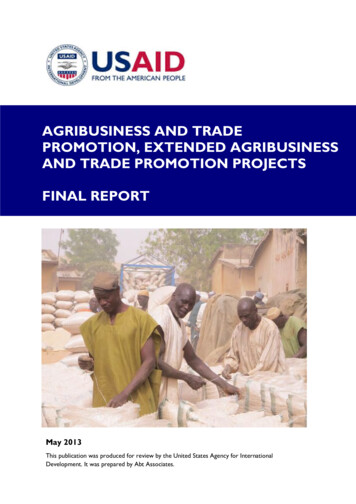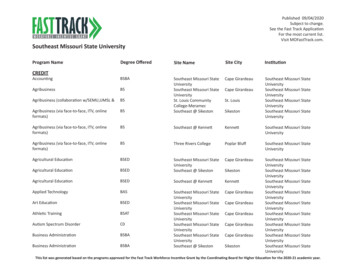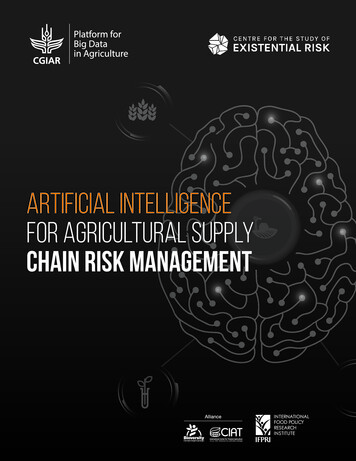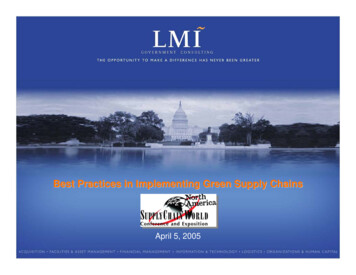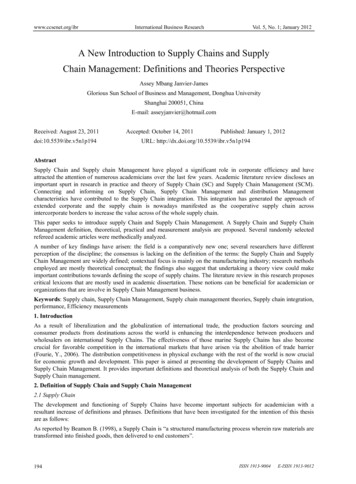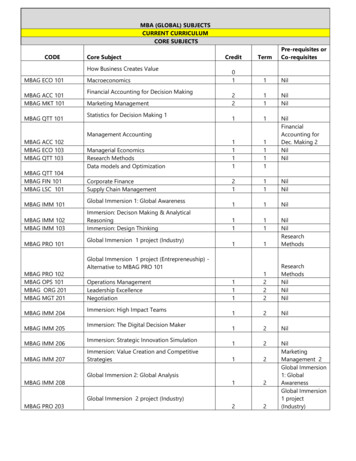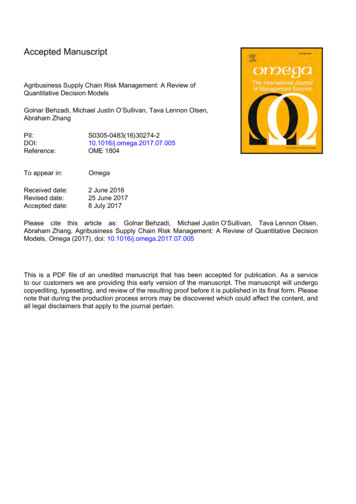
Transcription
Accepted ManuscriptAgribusiness Supply Chain Risk Management: A Review ofQuantitative Decision ModelsGolnar Behzadi, Michael Justin O’Sullivan, Tava Lennon Olsen,Abraham 6/j.omega.2017.07.005OME 1804To appear in:OmegaReceived date:Revised date:Accepted date:2 June 201625 June 20178 July 2017Please cite this article as: Golnar Behzadi, Michael Justin O’Sullivan, Tava Lennon Olsen,Abraham Zhang, Agribusiness Supply Chain Risk Management: A Review of Quantitative DecisionModels, Omega (2017), doi: 10.1016/j.omega.2017.07.005This is a PDF file of an unedited manuscript that has been accepted for publication. As a serviceto our customers we are providing this early version of the manuscript. The manuscript will undergocopyediting, typesetting, and review of the resulting proof before it is published in its final form. Pleasenote that during the production process errors may be discovered which could affect the content, andall legal disclaimers that apply to the journal pertain.
ACCEPTED MANUSCRIPTHighlights Providing the first literature review of risk management models specifically for agribusinesssupply chains. Focusing on specific sources of uncertainty in agribusiness industries. Providing new implications and further directions for developing the research in the context ofagribusiness supply chain risk management.CRIPT Providing the first literature review of risk management models specifically for agribusinessACCEPTEDMANUSsupply chains.1
ACCEPTED MANUSCRIPTAgribusiness Supply Chain Risk Management: A Review ofQuantitative Decision ModelsGolnar Behzadi*a , Michael Justin O’Sullivana , Tava Lennon Olsenb , Abraham Zhangc,daCRIPTDepartment of Engineering Science, Faculty of Engineering, The University of Auckland, Auckland 1010, NewZealandbInformation Systems and Operations Management, Business School, The University of Auckland, Auckland 1010,New ZealandcAuckland University of Technology (AUT) Business School, AUT, Auckland 1010 New ZealanddDepartment of Management Systems, University of Waikato Management School, Hamilton 3240, New ZealandAbstractSupply chain risk management is a large and growing field of research. However, within this field,mathematical models for agricultural products have received relatively little attention. This is somewhat surprising as risk management is even more important for agricultural supply chains due toANUSchallenges associated with seasonality, supply spikes, long supply lead-times, and perishability. Thispaper carries out a thorough review of the relatively limited literature on quantitative risk management models for agricultural supply chains. Specifically, we identify robustness and resilience as twokey techniques for managing risk. Since these terms are not used consistently in the literature, weMpropose clear definitions and metrics for these terms; we then use these definitions to classify theagricultural supply chain risk management literature. Implications are given for both practice andEDfuture research on agricultural supply chain risk management.1. IntroductionPTKeywords: Agribusiness supply chain, risk management, robust, resilientCEIn the past two decades, supply chain risk management (SCRM) has emerged as an important research topic [1]. Several reasons are behind this development: 1) globalization has made supply chainsAClonger and more complex; consequently, supply chains are now exposed to more risks and have become more vulnerable; 2) the lean management philosophy has become widely implemented in manyindustries; this philosophy advocates waste elimination/minimization and embraces just-in-time production/logistic; although it improves supply chain efficiency, the removal/reduction of redundancieshas resulted in greater supply chain vulnerability under adverse events; and 3) the world has paidincreasing attention to the many supply chain disruptions that have been caused by catastrophicevents (e.g., [2, 3, 4, 5]).Preprint submitted to Elsevier27th July 2017
ACCEPTED MANUSCRIPTAgribusiness plays an indispensable role in the world’s economy as a key source of food supplies.Agribusiness products have three specific characteristics that make risk management for agribusinesssupply chains (ASCs) more complicated when compared to risk management for typical manufacturing supply chains. These characteristics are seasonality, supply spikes (sometimes referred to as“bulkiness”), and perishability. Dealing with seasonality requires planning as growth is seasonalwhereas consumption is throughout the year. Further, most agricultural products have long supplylead times that cannot be easily altered against nature. Harvesting and post-harvest activities, including packing, processing, storage, and transportation, can be very demanding because of supplyCRIPTspikes. Furthermore, there is often significant time pressure on post-harvest activities as most agricultural products are perishable. Also, because of the perishability, there is a need for specific handling,storage, and inventory management. If not properly managed, a delay in transportation may causeANUSsubstantial loss of product value.In addition to product specific characteristics, risk management is important for ASCs because theyoften involve more sources of uncertainties than manufacturing supply chains [6]. In an ASC, thesupply process is related to biological production (food crops, meat, etc.), which is affected by weathervariability (e.g., droughts), disease (e.g., Psa kiwifruit disease), and pests (e.g., locusts). Such factorsMimply that both harvest levels and harvest times are subject to uncertainties. In addition, thesefactors can impact on the quality of the produce. In particular, in the processing stage, there areEDspecial risks associated with food quality and food safety (e.g., botulism risks). These uncertaintiesmake ASCs more vulnerable than typical manufacturing supply chains. Furthermore, recent practicesPTin agribusiness have added to the complexity of ASCs, thus making the application of risk management strategies more critical [7]. Such practices include the use of new marketing strategies (e.g., inCEproduct differentiation/proliferation) and the interlinked design of global supply chains [7].ACThis paper fills a gap in the literature by providing a review of quantitative models for ASC riskmanagement. Our focus is on risks at the supply chain level, and related risk management methodologies for ASCs that foster resilience and robustness, terms that we will carefully define. We reviewdifferent quantitative risk management (RM) approaches that provide resilience and robustness fora variety of agricultural products. As pointed out by [3] and [1], there are a lot of inconsistencies inthe meanings of SCRM terms. One contribution of this review is to suggest metrics for resilience androbustness.3
ACCEPTED MANUSCRIPTThe remainder of this paper is organized as follows. Section 2 outlines the scope of our reviewin Agribusiness Supply Chain Risk Management (ASCRM) and reviews related survey papers. Thekey concepts and terms in this review are defined in Section 3. Section 4 classifies the availablemodeling studies in ASCRM according to different aspects of product type, risk types, risk measures,and RM strategies (i.e., robustness and resilience). In this section, modeling approaches are furtheranalyzed for different types of agricultural products. At the end of Section 4, a specific overall summary of the section is provided that identifies gaps in the research literature. The paper is concludedCRIPTin Section 5 by proposing directions for future research.2. LiteratureApplications of quantitative models in agricultural problems date back to the 1950s and have beenaddressed widely in the literature [8, 7]. Modeling approaches in agribusiness have been predomin-ANUSantly used for problems related to transportation, distribution, harvesting, facility location, and farmplanning (e.g., [9, 10, 11, 12]), with a specific focus on farm planning problems. Key considerationsin agricultural problems (i.e., yield, harvest time, demand, etc.) are influenced by different sourcesof uncertainty such as weather conditions, animal or crop diseases, and price variability. Although,as described in the following, there are separate and extensive review studies on both quantitativeMrisk management and agribusiness models, we are not aware of any review paper thus far on SCRMEDmodels in agribusiness, which is the topic of our review.Articles [13], [14], [15], [16], [5], [1], and [17] reviewed the bulk of the quantitative SCRM liter-PTature, mostly in the context of manufacturing industries. Agribusiness decision models have beenreviewed in the areas of production, harvesting, and distribution [8, 7, 18, 19], facility locations [11],CEsupply-side resource utilization [20], ASC planning challenges [21], and operational issues that result in post-harvest waste [22]. Further, [23] reviewed quantitative ASC models in the contexts of:ACplanting, harvesting, production, distribution, and inventory; [24] extended the review of agribusinessproblems (in the context of supply chains) in considering factors of uncertainty. However, neither ofthe review papers discuss risk management strategies, so cannot be considered as reviews of SCRM.Thus, as depicted in Figure 1, to the best of our knowledge, there is no review specific to quantitativemodels in the joint area of SCRM and agribusiness. As mentioned above, this overlap will be coveredby our review paper.4
ACCEPTED MANUSCRIPTFigure 1: Venn diagram on the research gap in literature reviews/survey papers[13] [14] [15][16][5] [1][17]SCRM[8][25][11] [7][20][18][21][19][22][23] [24]1AgribusinessANUSCRIPTThe scope ofthis review paperNote that risk management is not new to agribusiness planning. For instance, [26, 27] introduced thebasic concepts of risk management in agriculture. Further, [25] reviewed farm decision-making underrisk from several aspects such as utility functions, farmer risk preferences, and response approachesMto both short-term and long-term uncertainty. However, the main concern of these aforementionedstudies was farm level risks and uncertainties, whereas we have focused on risks at the supply chainEDlevel.PTWe reviewed papers from different journals in Operations Management (OM), Operations Research(OR), Supply Chain Management (SCM), and agriculture. We searched the Scopus database usingCEcombinations of keywords including “risk management,” “quantitative risk management,” “supplychain,” “operations research,” and “agribusiness”. In addition, we went through all the papers sur-ACveyed in the review papers from Figure 1 for SCRM papers with an agribusiness application (left handside survey papers) and agribusiness papers that focused on SCRM (right-hand-side survey papers).We defined supply chain broadly as any paper that modeled multiple locations or firms.We believe [28], published in 1993, is the first quantitative study in the field of agribusiness thatconsidered risks in supply chains, although without directly referring to the term “supply chain.”1Article [24] reviews agribusiness problems in supply chain structures and includes uncertainty attributes; however,as risk management strategies have not been clearly discussed in this review, the review has not been categorized underthe SCRM section.5
ACCEPTED MANUSCRIPTBefore that, risks in agribusiness had only been discussed at the farm level (see [26]). Article [28]studied a vegetable processing supply chain problem with two echelons that consider production,trimming, and processing decisions under uncertain climatic factors. In contrast with [28], most ofthe reviewed papers after 2000 have explicitly referred to the term supply chain in their studies.As 1993 appeared to us to be a late date for a first study, we carried out further research on the timingof the field. The term “supply chain management” appears to have first been used in an interviewin the Financial Times in 1982 [29]. However, the concept of multi-echelon inventory control wasCRIPTaddressed well before the introduction of “supply chain management (SCM)” [29]. Our search on“multi-echelon” and “agribusiness” yielded no RM papers earlier than [28]. It appears that when aflurry of articles and books came out on the subject of SCM in the mid-1990s, the concept began to beused in other fields of study, such as agribusiness. However, a recent review on SCRM indicates thatANUSthe concept of risk management has still received noticeably less attention in the field of agribusinessand biological sciences compared to fields such as engineering, decision sciences, and business [1].The latter statement has been supported by the findings of our review that particularly focused onagribusiness supply chain risk management studies. Table 1 lists the main issues addressed in theliterature of quantitative SCRM modeling in agribusiness from 1993 until the present, ordered byACCEPTEDMdecreasing publication date.6
ACCEPTED MANUSCRIPTTable 1: Summary review of the literature in quantitative ASC risk managementReference[30][31, 32][33]Single-period, multi-product food production planning model (with applications incocoa/wheat/palm oil/corn/soybean supply chains) that maximizes the expectedprofit of the processing firm by determining the procurement policy under fixed proportional production.Handling model for an export-oriented Canadian wheat supply chain that providessafety and quality assurance under minimum farmers’ total cost including cost of: lossat test point, contamination penalty, and risk control effort.Supermarket-farmer coordination model in an agricultural commodity supply chainthat distributes the profit and improves its effectiveness.Supply planning model for linseed oil processor in a polymers production supply chainthat maximizes the expected profit under raw material quantity/quality and marketdemand uncertainty.Buyer-backup supplier coordination model that maximizes the expected profit bydetermining the buyer firm’s reserve quantity and the backup supplier’s installedcapacity in a single-period (short-life) food supply chain.Multi-period capacity management model that maximizes the expected revenue ofan agri-food processor (the palm oil mill) by determining processing/storage capacityinvestments for the first period and periodic inventory decisions for the followingperiods.Production, transportation, and marketing model that minimizes the expected totalcost of production by determining the delivery waiting time for the final product andthe processing time of production in a perishable fresh-crop supply chain.Post-harvest logistics management model for respiring, deteriorating fresh crops thatmaximizes the total expected inventory and shortage costs, by determining proper lotsizes for finished products in RTIs (return transport items) and selling price duringthe deterioration process, under a stochastic lead-time of receiving RTI from buyer,in a closed-loop supply chain.Aggregate production planning for a frozen orange juice supply chain that minimizesthe total cost of supply, inventory, and shortage under uncertainty in citrus juiceacidity specification.Production planning model for a biofuel supply chain that maximizes expected profitby determining purchasing, processing, and production decisions.Robust supply chain design model applied in an agricultural (rice) supply chain thatmaximizes expected profit and minimizes the ratio of performance deviation to avariation of uncertain parameters by determining supply chain flow and location decisions.Single-period farming, procurement, and process planning model that maximizes expected profit in the processing firm by determining proper ordering quantities of allsources and their corresponding processing rates in a cocoa production supply chain.Multi-period operational production and distribution planning model in a crop (i.e.,tomato and bell pepper) supply chain that maximizes the growers’ expected profitsduring harvest under uncertainty by making a trade-off between freshness and cost.[43]extends [44] by considering various sources of uncertainty, particularly on a crop’sprice and yield.Multi-objective stochastic model for a hydrocarbon bio-refinery supply chain thatminimizes the annual cost and financial risk by determining network design, technology selection, production investment, and planning decisions.Closed-loop supply chain design model with applications in both food and high-techmanufacturing industries that minimizes the total supply chain cost under uncertaintyassociated with purchase costs and demand.Fuzzy network design in a consumable vegetable oil supply chain that minimizes thetotal transportation cost and labor sources under probabilistic warehousing or refinerycapacities and market demand.Tactical planning model for an olive oil supply chain that maximizes expected profitby determining farm areas and best seeding times.CRIPT[34]Issue 2]AC[43], [44][45][46][47][48]7
ACCEPTED MANUSCRIPTSummary review of the literature in quantitative ASC risk management continuedReferenceIssue addressed[49]Single-period multi-product meat supply chain design model that maximizes thepacker’s expected profit, plant utilization, and animal non-uniformity given procurement, processing, and production decisions.Production planning model for multi-period, multi-product (perishable/powder) dairysupply chain that maximizes the expected profit by determining the optimal salespolicy.Single-period production planning model that maximizes the expected return by determining the optimal amount of space to be leased for production and the quantityof olives to be provided from external sources under yield and yield-dependent costuncertainties in a Turkish olive oil supply chain.Investment and production planning model in a single-period biofuel supply chain thatmaximizes the expected profit by determining investment decisions in a processingplant and flow decisions along the supply chain.Robust aggregate production planning model that minimizes the total cost of production, staffing, inventory, transportation, and shortage and maximizes the customers’satisfaction in a wood and paper production supply chain under uncertainty associated with cost parameters and demand.Inventory model under supplier-retailer collaboration on demand forecasting in a perishable agri-food supply chain that maximizes the expected profit by determining anoptimal replenishment policy.Robust optimization model for harvest planning in a grape (wine) supply chain under yield (harvest productivity) uncertainty that maximizes the expected profit bydetermining the optimal labor assignments at different harvest-blocks and times.Enterprise decision model (i.e., to join to or form a co-op) in a dairy supply chainthat maximizes the expected income of farmers by determining co-op decisions (aboutsize, conditions, and product quantity), production, and shipment planning.Winery allocation model in a wine supply chain that maximizes the expected profitcomposed of sales and salvage value minus total production, packaging, and storagecosts under demand uncertainty.Contract model between a large seed supplier and multiple retailers in a seeds supplychain that maximizes the expected total channel of profit by determining contractparameters that result in supply chain coordination.Inventory model for perishables in a fresh vegetable supply chain that maximizesexpected profit by determining the optimal planting batch in each harvest period.Robust multi-site, medium-term production planning model that minimizes the expected total cost for the producer including costs of production, labor, workforcechange, shipment, and inventory by determining shipment, inventory, sale, and labordecisions in a cotton/silk (lingerie) supply chain.Production planning model for a premium-brand tomato supply chain that maximizesthe expected profit and meets the minimum service level by balancing overage cost,especially related to perishability, and underage cost of lost customers.Capacity management and logistic network design model for an export fruit supplychain that maximizes throughput by determining the optimal flow between nodes andinvestigating the possibility of a capacity extension.Production planning and scheduling model in a multi-commodity fruits/juices (applesand pears) supply chain that maximizes the expected sales’ income by determiningstorage, process, and sales policies.Investment management in a concord grape and juice production supply chain thatminimizes the expected total cost of underage and overage through a trade-off betweenoverinvestment and lack of capacity by determining the optimal pressing rates.Single long-period (two-year) production planning model that maximizes expectedsales in an olive oil supply chain by determining optimal leased farms and the production D[58]PT[59]AC[61]CE[60][62][63][64][65]8
ACCEPTED MANUSCRIPTSummary review of the literature in quantitative ASC risk management-further continuedReferenceIssue addressed[66, 67]Sequential two-period newsvendor harvest/inventory planning model in a hybrid seedcorn supply chain that maximizes the margin by determining the number of acresin each period (in the 2003 version the model has been extended to multi-productproduction planning).Production planning model in an Ilium flower supply chain that maximizes the expected total revenue by determining quantities of varieties of bulbs and flowers in eachstage of the supply chain.Facility location/allocation model that minimizes the expected production and transportation costs under a green production scheme, uncertain daily demand, and scenarios of supply failures in a dairy (raw milk) supply chain.Medium-range horizon multi-period production planning model in a tomato supplychain that minimizes the total packing cost for the packing plant and the penalty costfor the delayed harvest.Multi-period production model in a vegetable processing supply chain that minimizesthe total harvest and production cost and meets capacity and market limitations bydetermining harvesting, flow, processing, and logistics decisions.[68][69]CRIPT[70][28]ANUSAs demonstrated in Table 1, quantitative agricultural risk models have been discussed in variouscontexts of farm management, production management, scheduling, and pest/disease managementfor supply chains in different crops/livestock. The following characterizes this work further andhighlights gaps for future research.M3. Agribusiness SCRM Classification TermsEDIn this section, we identify the key concepts of our review in agribusiness supply chain risk management (ASCRM). In particular, we describe different aspects that have been discussed in the reviewedPTpapers, which include: product types, risk types, and approaches to the modeling and managementof risk. In Section 4, we use these aspects to classify the papers in Table 1.CE3.1. Agribusiness Supply Chain Product TypesAn agribusiness supply chain encompasses all components of a “farm-to-fork” process for a given foodACproduct; these include various stages related to supply, production, post-harvest, storage, processing,distribution, and linkages between components. Thus, the basic concepts are similar to manufacturingsupply chains. However, the additional characteristics of ASCs (as described in Section 1, especiallyperishability) can make ASCs relatively more complex.ASCs can be classified into different classes by the types of products produced. Some agricultural foodproducts are referred to as crops (and sometimes agri-food crops) and include products obtained directly from plants. Other agricultural products such as cattle, meat, or seafood are known as livestock.9
ACCEPTED MANUSCRIPTThe livestock category also includes dairy products (e.g., milk, cheese) and non-food products (e.g.,wool, hair, silk). Importantly, both livestock products and crops are either perishable or long-life.For example, fruits, fresh vegetables, and meat products are perishable. However, wheat and woolare considered to be long-life. Perishable crops can be further classified into respiring or non-respiringproducts and perishable livestock is divided into three classes of fresh, chilled, and frozen products.Within agri-foods, respiring crops and fresh livestock products are extremely prone to risk becauseof their particular biological characteristics. In Figure 2, we illustrate the classification of differentANUSAgribusiness bleLong-lifePerishableCRIPTproducts within ASCs.FreshNon-respiringChilledFrozenPTFigure 2: Product classification of ASCsCEAlthough crops and livestock are common product classifications for ASCs (e.g., in [6]), from amodeling standpoint, agricultural products can be classified as perishable or long-life because modelsthat include perishability are often quite different from those that do not. Within the perishableACcategory, there are second-order characteristics, such as respiring versus non-respiring (for crops) andfresh versus chilled/frozen (for livestock, e.g. meat), that can also be considered when modelingperishability. In Section 4, we will divide the literature into long-life and perishable products. First,in the following subsections, we highlight the modeling differences between these two categories.3.1.1. Long-life Agricultural ProductsThe basic modeling difference between long-life and perishable agricultural products is that modelsin the category of long-life agriculture products are usually considered in multiple periods over a10
ACCEPTED MANUSCRIPTlong time horizon. Studies in the context of risk management for long-life agricultural products areaimed at a variety of decisions such as crop planning, harvest and cultivation scheduling, capacityinvestment, production planning of processed foods, food handling, and facility location. Two recentrepresentative examples of such work include [32] and [30].Article [32] studied a handling problem for an export-oriented Canadian wheat supply chain thatconsiders safety and quality issues. They developed a supply chain model to determine appropriatetesting strategies by minimizing the farmer’s total costs including the cost of loss at a test point, aCRIPTcontamination penalty, and a risk control effort under risks of a farmers’ misrepresentation of dataand technological failure. They proposed a simulation approach in the context of ASC with detailedassumptions including assumptions on an individual farmer’s behavior.ANUSA second example of an ASC risk model in the context of long-life agriculture is provided by [30].They investigate a capacity management problem in a palm oil supply chain. The model is developedas a multi-period supply chain that maximizes the expected revenue of an agri-food processor (thepalm oil mill) through a dynamic stochastic programming approach with a series of two-stage models.The optimal solution is found by determining processing/storage capacity investment decisions in theMfirst period, and making inventory decisions under yield and price uncertainties in the remainingperiods. Their model compares three capacity portfolios that address processing dominated, storageEDdominated, and mixed processing policies.PT3.1.2. Perishable Agricultural ProductsRisk management approaches for perishable agriculture products require particular consideration be-CEcause of the additional level of vulnerability associated with perishability. A simple approach to dealwith perishability and short lifecycles is newsvendor modeling (i.e., through a single-period inventory management model). One recent representative example of such modeling is [49], who discussACprocurement strategies in a beef supply chain in order to minimize the packer’s expected cost underyield and demand uncertainty. They studied mixed spot and contract strategies under single periodplanning. The newsvendor model is used to reflect the perishability of beef products. Under the optimal solution, the expected total cost of the beef packer is minimized by determining procurement,processing, and production decisions.Perishability can also be modeled over multiple periods by considering estimation approaches on11
ACCEPTED MANUSCRIPTthe remaining shelf-life/freshness of the agricultural products at risk. Such models are capable oftracing the impact of a disruptive event or risk from one planning period to another. However,shelf-life/perishability modeling considerations increase the complexity of the proposed mathematical models.A recent example of a multi-period model is [37]’s study of a fresh fruit producer that sells tolocal and international markets under known (Make-To-Order: MTO) or uncertain (Make-To-Stock:MTS) demands and transportation disruptions. In this problem, the international market is moreCRIPTprofitable but has the risk of transportation failures. Such failures affect both unfinished (ordered,not yet processed), and finished (processed, not yet delivered) products. Indeed, the waiting timeuntil delivery is an important threat for perishable products. Thus, the key decision is whether towait or to sell the finished product in the local market at a discounted price. However, for unfinishedANUSproducts, the decision is made on whether to slow down or change the process to adjust to a suitabledelivery time. These decisions are made to prevent perishability and loss, and ultimately, minimizethe expected total cost of the production system.3.2. Supply Chain Vulnerability and RiskMSupply chain vulnerability is “the propensity of risk sources and risk drivers to outweigh risk mitigation strategies, thus causing losses and adverse supply chain consequences” [71]. Hence, vulnerabilityEDis
The scope of this review paper [13] [14] [15] [16][5] [1][17] SCRM Note that risk management is not new to agribusiness planning. For instance, [26, 27] introduced the . The term \supply chain management" appears to have rst been used in an interview in the Financial Times in 1982 [29]. However, the concept of multi-echelon inventory control was
